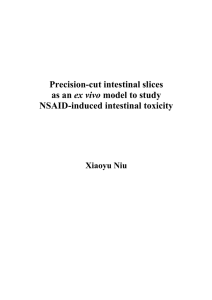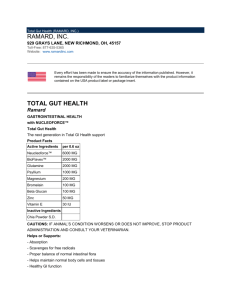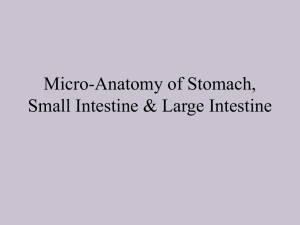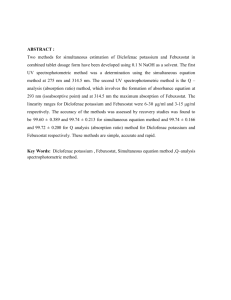Evaluation of Hydroxyethyldiclofenac
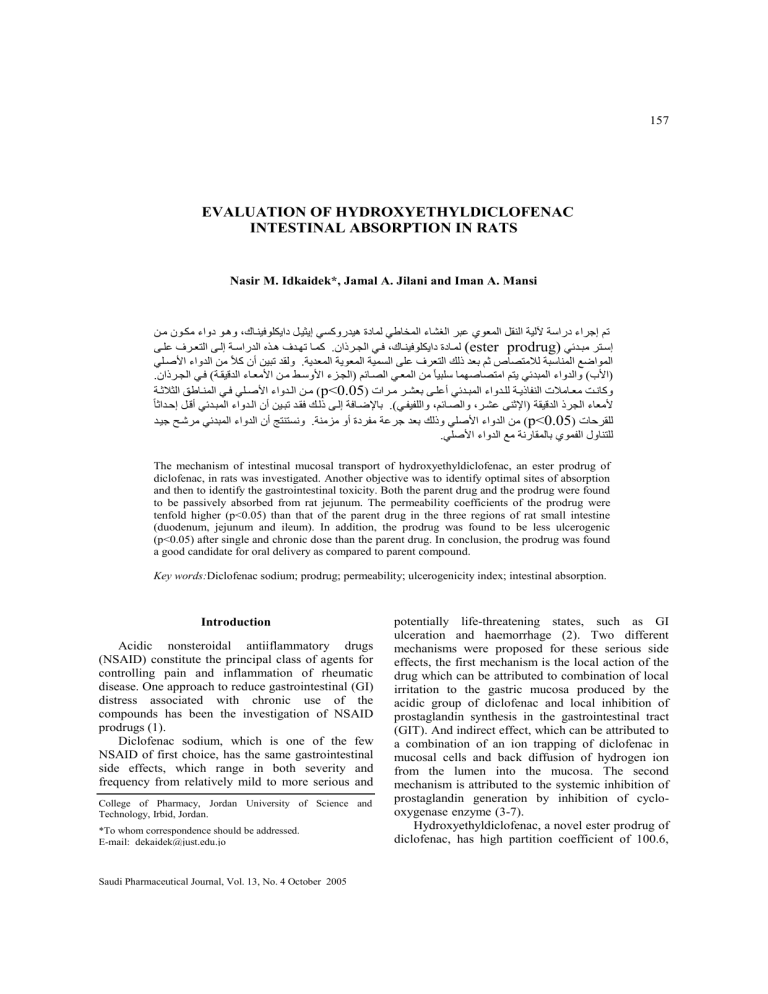
157
EVALUATION OF HYDROXYETHYLDICLOFENAC
INTESTINAL ABSORPTION IN RATS
Nasir M. Idkaidek*, Jamal A. Jilani and Iman A. Mansi
لن وللن ءاود ولهو و النييوولياد لليثيإ يسكورديه ةدامل يطاخملا ءاشغلا ربع يوعملا لقنلا ةيللآ ةسارد ءارجإ مت
للوع ةرللع لا لللإ ةللساردلا ا لله ةدللدت اللمك ه اارلل لا يللي و اللنييوولياد ةداللمل (ester prodrug) ي دللبن ر للسإ
يولصلأا ءاودلا ن ًلاك أ يبت دقلو هةيدعملا ةيوعملا ةيمسلا و ع ةرع لا كلا دعب مث صاص نلال ةبسانملا عضاوملا
ه اارل لا يلي )ةلقيفدلا ءالعنلأا لن لسولأا ءال لا( م الصلا يلعملا ن ًايبوس امدصاص نا م ي ي دبملا ءاودلاو )بلأا(
ةللثلاثلا قطا للنملا يللي يوللصلأا ءاودلللا للن ) p<0.05
( نارللن رللشعب للوعأ ي دللبملا ءاودللول ةلليااةنلا نلاناللعن مللناكو
ًاثادل إ للفأ ي دلبملا ءاودللا أ يلبت دلقي كللا للإ ةيالضلإاب ه)يلةيةولاو وم الصلاو ورلشع نثلإا( ةقيفدلا ار لا ءاعنلأ
دليج لشرن ي دبملا ءاودلا أ ج ن سنو هةننان وأ ةدرةن ةعرج دعب كلاو يوصلأا ءاودلا ن ) p<0.05
( نا رقول
هيوصلأا ءاودلا عن ةنراقملاب يومةلا لوان ول
The mechanism of intestinal mucosal transport of hydroxyethyldiclofenac, an ester prodrug of diclofenac, in rats was investigated. Another objective was to identify optimal sites of absorption and then to identify the gastrointestinal toxicity. Both the parent drug and the prodrug were found to be passively absorbed from rat jejunum. The permeability coefficients of the prodrug were tenfold higher (p<0.05) than that of the parent drug in the three regions of rat small intestine
(duodenum, jejunum and ileum). In addition, the prodrug was found to be less ulcerogenic
(p<0.05) after single and chronic dose than the parent drug. In conclusion, the prodrug was found a good candidate for oral delivery as compared to parent compound.
Key words: Diclofenac sodium; prodrug; permeability; ulcerogenicity index; intestinal absorption.
Introduction potentially life-threatening states, such as GI
Acidic nonsteroidal antiiflammatory drugs ulceration and haemorrhage (2). Two different mechanisms were proposed for these serious side
(NSAID) constitute the principal class of agents for effects, the first mechanism is the local action of the controlling pain and inflammation of rheumatic drug which can be attributed to combination of local disease. One approach to reduce gastrointestinal (GI) irritation to the gastric mucosa produced by the distress associated with chronic use of the acidic group of diclofenac and local inhibition of compounds has been the investigation of NSAID prostaglandin synthesis in the gastrointestinal tract prodrugs (1).
(GIT). And indirect effect, which can be attributed to
Diclofenac sodium, which is one of the few a combination of an ion trapping of diclofenac in
NSAID of first choice, has the same gastrointestinal mucosal cells and back diffusion of hydrogen ion side effects, which range in both severity and from the lumen into the mucosa. The second frequency from relatively mild to more serious and mechanism is attributed to the systemic inhibition of
College of Pharmacy, Jordan University of Science and
Technology, Irbid, Jordan.
*To whom correspondence should be addressed.
E-mail: dekaidek@just.edu.jo
Saudi Pharmaceutical Journal, Vol. 13, No. 4 October 2005 prostaglandin generation by inhibition of cyclooxygenase enzyme (3-7).
Hydroxyethyldiclofenac, a novel ester prodrug of diclofenac, has high partition coefficient of 100.6,
158 IDKAIDEK ET AL good stability in 1N HCl (t
1/2
=22 hrs) and acceptable degradation rate in human plasma (t
1/2
=
1.12 hrs) but relatively low water solubility of 0.077 mg/ml (8,9).
The objectives of this report were to study the permeability of hydroxyethyldiclofenac through different regions of rat small intestine, mechanism of intestinal absorption using in-situ intestinal perfusion method and to compare results obtained with that measured for diclofenac sodium.
Materials
Diclofenac sodium was obtained from the
Jordanian market (Diclogesic®) and was used as received. Hydroxyethyldiclofenac was synthesized in Jordan University of Science and Technology
(JUST). All other chemicals and reagents were either analytical or HPLC grade and were used as received.
Distilled deionized water was used in the preparation of buffer solutions and mobile phase. pH measurements were performed using model 3310,
Genway, UK, pH meter. Adult Sprague-Dawley rats
(250-400 g) were used in intestinal perfusion and ulcerogenicity studies. A variable speed syringe pump, SAGE Instrument, model 355, USA, was used for pumping the perfusate into rat small intestine.
Methods
1. Perfusion solution:
The perfusate solution was prepared by dissolving 0.3 mM of either parent drug or prodrug in phosphate buffer (48 mM NaCl, 5.4 mM KCl, 28 mM Na
2
HPO
4
, 43 mM NaH
2
PO
4
, 35 mM mannitol,
10 mM glucose, 100 g/L of propylene glycol used as a cosolvent). The pH and the osmolarity were 6.5 and 300 mOsm, respectively (10).
2. Assay:
Diclofenac sodium and its ester were analyzed by high performance liquid chromatography, which was performed using a Shimadzu pump model LC-
10ADVP , with 100 μl loop injection valve, equipped with a variable wavelengths Shimadzu detector, model SPD- 10 AV VP and controlled by a Shimadzu system controller, model SCL-10 AVP . In these methods a reversed-phase HPLC columns, 250 ×
4mm Packed with purosphere, RB-18 (5 μm particles), Merck, Germany were used. The column effluent was monitored using a Shimadzu computer program. The mobile phase consisting of acetonitrile: sodium acetate 0.006M buffers (140:90) and pH adjusted with glacial acetic acid to 5.64. The flow rate of the mobile phase was 1ml /min and the detector wavelength was set at 280 nm and at a sensitivity of 0.100 AUFS (9).
All drugs assayed by this method appear at the same retention time on the HPLC chromatogram about 4.5 min for diclofenac and 7 min for hydroxyethyldiclofenac prodrug and 11 min for the internal standard (hydroxyethyl mefenamate).
Linearity of the method was determined (r 2 =
0.994 and 0.9996 for parent and prodrug respectivly). For precision and accuracy, RSD was
0.971 % and DFA (difference from actual) was 1.08
%. Interday and intraday coefficient of variation were both less than 10 %.
3. In-situ perfusion experiments:
Single pass intestinal perfusion technique was used. Three rats were fasted over night with water ad libitum.
The rats were anesthetized using Ketamine
HCl (Calypsol® inj. USP, 50 mg/ml). The anestheticzing agent was given intramuscularly in the thigh in a dose of 100 mg/kg, which was sufficient to keep the animal anesthetized for 1.5 hour, and so a second dose of 45 mg/kg was required at the middle of the experiment (11). The rat was laid in supine position on a warmer cartoon platform, with the body temperature maintained at 37 o C by irradiating with
100-watt tungsten lamp throughout the experiment
(12). Once the animal was adequately anesthetized, the abdomen area was shaved and cleaned with ethanol (13). After onset of deep anesthesia, the abdomen was opened by midline incision and the entire intestine was then exposed (14). Care was taken not to disturb the mesentery (15). The organ was kept moist with warm normal saline at 37 o C
(12).
The desired intestinal region was identified, the first 8 cm of the rat small intestine was used as duodenum, the next 35 cm as the jejunum, the last
25 cm proximal to the ileocecal junction as the ileum and the segment between the jejunum and ileum was considered as the jejunoileal junction (14). A small incision was made at both ends of an approximately
10-15 cm long segment of the exposed rat small intestine (16). A polyethylene canulas were inserted at each end of the segment and were tied in place with a loop of silk sutures placed tightly around the
Saudi Pharmaceutical Journal, Vol. 13, No. 4 October 2005
EVALUATION OF HYDROXYETHYLDICLOFENAC 159 intestine, forming a seal that prevented perfusate from leaking through the canula junction (12). The canula in the proximal end of the intestinal segment was connected to a perfusion syringe on a variable speed compact infusion pump and the distal end was canulated for perfusate collection (12). Tubing between the infusion pump and the intestine was inserted into water bath and maintained at 37 o C (11).
The intestinal segment was cleaned by perfusing with 37 o C normal saline at a flow rate of 0.23 ml/min until the perfusate was clear, the remaining saline was cleared by infusing air (16). The intestinal region under study was carefully arranged in a uniform S to multi-S pattern to avoid kinks and insure consistent flow. Saline soaked, warmed, sterile cotton was used to cover the opened body cavities to prevent loss of body temperature and maintain the tissues in a state of hydration (16).
Drug solution was perfused into the intestine segment at a perfusion rate of 0.23 ml/min. Intestinal effluent samples were collected into a 10-ml measuring cylinder every 10 min for up to 100 min.
The volume of each effluent fraction was measured
(15). After collection, the sample was filtered and kept frozen at –20 o C until analyzed by HPLC (17).
At the end of the experiment, the drug was expelled by infusing air through the intestinal segment. The segment was gently separated from the mesenteric tissue and removed from the body. The length of the segment was measured with a ruler and used for permeability calculation (13). The experiments were performed using different regions of rat small intestine (duodenum, jejunum and ileum) for the parent drug and the prodrug to find out if they are absorbed from the whole GIT or from certain region of the intestine. In addition, two concentrations
(40μg/ml and 100 μg/ml) of each drug were examined to study the mechanism of drug absorption.
4. Stability of hydroxyethyldiclofenac:
The stability of hydroxyethyldiclofenac in the intestinal lumen and in the intestinal homogenate was evaluated and the effect of freezing at –20 o C on the stability of hydroxyethyldiclofenac and its adsorption to the perfusion syringe and tubes were also evaluated according to Kronahl et al (17). In breif, the prodrug was incubated in the intestinal lumen fluid or the intestinal homogenate at 37 0 C.
Frequent samples were withdrawn at 15, 30, 60, 90,
130 and 1440 minutes and mixed immediately with
50% acetic acid to stop enzymatic reaction, then assayed for the prodrug by HPLC.
Table 1
:
Method to measure ulcerogenicity index:
Observation Score
No lesions
Punctiform lesions (lesions less than 1 mm)
Five or more punctiform lesions
One to five small ulcers (1-2 mm)
0.0
0.5
1.0
2.0
More than five ulcers or one large ulcer (2-4 mm)
More than one large ulcer (greater than 4 mm)
3.0
4.0
From ref. (6)
5. In-vivo ulcerogenicity studies:
Male Sprague-Dawley rats (170-200g) were used. Ten rats were fasted for 12 hr prior to administration of drug solutions and for 4 hr postdosing. Food was available for all other times, and free access to water was provided throughout the experiment. One group of rats (control) received no drug treatment, while other groups received either the parent drug or the prodrug. Doses, equivalent to
1mg/kg (in saline), were administered orally to each group. The rats were subjected to single dose and chronic dose regimen, which utilized the same daily dose for 4 days. Doses were chosen to be theraputic doses of 1 mg/kg. At 24 hrs following the last dose of chronic treatment and 4 hrs after single dose, the rats were sacrificed in an ether chamber, the stomach was dissected out of the body along with the first 5 cm of the intestine, then rinsed with saline and the contents of the stomach were emptied. The stomach and the intestine were then excised open along the greater curvature and gently wiped clean with a swap dripped in saline. The mucosal damage was examined grossly using a magnifier. The severity of mucosal damage was assessed according to table (1).
Based on the severity of the mucosal damage, the specimen was assigned on ordinal score as per the score scheme. For example, a specimen with five punctiform lesions, two small ulcers and one large ulcer was assigned a score of 3.0. However, the control specimens did not exhibit the formation of lesions or ulcers and, accordingly, the control have a score of 0.0. The scores were averaged and the mean
Saudi Pharmaceutical Journal, Vol. 13, No. 4 October 2005
160 IDKAIDEK ET AL score was tabulated as the ulcerogenicity index for the drug solution administered (4, 6).
6. Data analysis:
The fraction of dug not absorbed at steady state during perfusion was described by the following equation:
F
C ' out
C ' in
Where C' out
and C' in
are the rates of drug leaving and entering the intestinal segment perfused, respectively, and equal to the product of volumetric flow rate and drug concentration, Q out
* C out
and Q in
* C in
, Q out
and Q in
may differ due to water absorption or secretion during perfusion. Effective permeability coefficient (cm/s) can be obtained from the following equation, (18)
P eff
Q
2 ln
C ' out r
C l
' in .......
( 2 )
Where A is the effective surface area per unit length of the segment perfused (cm 2 /cm), which in practice is often substituted by the anatomical surface area ( 2π r, where r is the anatomical radius which was measured to be 0.182 cm). l is the anatomical length of the intestinal segment perfused.
The preceding analysis can be related to the pharmacokinetic analysis through a mass balance on the tube, this approach gives:
dm/dt = 2π rl P eff
C in
(3)
While the pharmacokinetic analysis would give,
dm/dt = K abs
V C in
(4)
Where K abs is the first-order absorption rate constant and V is the volume of the intestinal segment and equal to π r 2 l, (19) hence,
K abs
= 2 P eff
/r (5)
The half-lives (t
1/2
) for the disappearance of hydroxyethyldiclofenac in intestinal wash and homogenate were calculated from the degradation rate constants obtained by linear regression of the firstorder plots of hydroxyethyldiclofenac concent-ration versus time. The permeability data and ulcerogenicity index are presented as mean ± SD.
7. Statistical analysis:
Analysis of variation (ANOVA) was used to investigate the differences in P eff at the three regions of rat intestine, while student-paired t-test (2 tailed) was used to investigate the differences in P eff at two different concentrations and the difference in ulcerogenicity index between parent drug and prodrug at single and chronic doses. Significant difference was considered at P-values <0.05.
Results and discussion
As for any new entity, if this prodrug can not penetrate the intestinal epithelium it can not be developed as a pharmaceutical formulation and because of the limited water solubility then a uniform drug absorption over most of the length of intestinal tract will propose a sustained-release formulation.
The intestinal perfusion technique has been used in studying various drug absorption characteristics including the mechanism of absorption, physicochemical, or physiological factors governing absorption and permeability differences at different intestinal regions. The techniques has facilitated drug screening in the pharmaceutical industry because of its simplicity, efficiency and a good correlation between oral absorption and intestinal permeability in human and rat models (13).
In a rat perfusion model, the effective permeability is based on disappearance of the drug from the intestinal segment and is considered to reflect transport across the complex apical enterocyte membrane (20). It has been shown that rat
P eff values obtained by perfusions, correlate with high accuracy to both P eff and extent of absorption in vivo in human (10)
In general, it has been reported that increasing the hydrophobicity of a drug yield a higher permeability values (14). And this was consistent with the results obtained as hydroxyethyldiclofenac, which is of higher hydrophobicity than diclofenac sodium, has a significantly higher (p < 0.001) permeability coefficient compared to diclofenac sodium from different regions of rat small intestine as shown in Table 2.
The permeability coefficients of diclofenac sodium and hydroxyethyldiclofenac were summarized in Table 2. Diclofenac sodium shows no significant difference between the three intestinal regions (P =0.718). Similarly, the permeability of
Saudi Pharmaceutical Journal, Vol. 13, No. 4 October 2005
EVALUATION OF HYDROXYETHYLDICLOFENAC 161
Table 2: Estimation of K abs.
, t
0.5.abs.
of diclofenac sodium and hydroxyethyldiclofenac in different regions of at intestine.
Diclofenac sodium Hydroxyethyldiclofenac
Parameter region
K abs.
(sec -1 ) P eff
X 10 -4 (cm/sec)* K abs
(sec -1 )
.
P eff
X 10 -3 (cm/sec)*
Duodenum
Jejunum
Ileum
Average
2.185 × 10 -3
1.26 × 10 -3
1.109 × 10 -3
1.518 × 10 -3
2.01 (0.45)
1.16 (0.32)
1.02 ( 0.33)
1.400
* Values are means (SD) hydroxyethyldiclofenac shows no significant difference (p = 0.989) between these regions, which indicates the uniformity in drug absorption along the rat small intestine and so suggests the possibility of making a better sustained release formulation in case of the prodrug.
It is believed that anti-inflammatory drugs may modulate the small intestine tight junction thereby inducing increase in paracellular permeability, which is suggested to be prerequisite to NSAID-induced ulceration. Similar to its effect in rats, diclofenac enhances human intestinal permeability (21). This fact explains the increase in permeability coefficient upon increasing the concentration of diclofenac sodium in the perfusate. This suggests that paracellular route may contribute to some extent to the passive absorption of diclofenac in rat jejunum.There was no significant difference in the permeability coefficient of hydroxyethyl-diclofenac as the perfusate concentration has increased from 40
μg/ml to 100 μg/ml. This proposes that both are passively absorbed but unlike diclofenac sodium, hydroxyethyldiclofenac does not enhance its permeability in rat intestine.
Both drugs were stable in the perfusion solution during the perfusion experiment, no adsorption to the syringe or plastic tubes could be detected and they were stable during freezing for a period of more than one month.
Hydroxyethyldiclofenac underwent a first-order degradation with a degradation rate constant of
0.0241 hr -1 and a half-life of 27 hrs which means that it is stable in the intestinal lumen and will not degrade during the experiment. However, it will be
0.01609
0.01375
0.01788
0.015907
1.48 (0.34)
1.27 (0.47)
1.65 (0.51)
1.463 bioconverted to the parent drug in liver and blood after intestinal absorption (8).
In addition, hydroxyethyldiclofenac has also acceptable stability in the intestinal mucosa having a degradation rate constant of 0.0043 min -1 and a degradation half-life of 2.7 hrs. As degradation half- lives of hydroxyethyldiclofenac in the intestinal lumen and in the gastric mucosa are compared to the absorption half-life shown in Table 2, it can be noted that absorption half-life is much smaller than the degradation which means that prodrug is absorbed before occurring of any significant degradation.
Hence it was not considered in the statistics calculations .
As previously stated, the direct contact mechanism in gastric ulceration is a combination of the local irritation produced by the free carboxylic acid group of NSAID and the local inhibition of the cytoprotective actions of prostaglandins on the gastric mucosa. As hydroxyethyldiclofenac remains intact over more than 4 hrs time period in simulated gastric fluid and 2 hrs in the brush boarder, it can be assumed that it is absorbed intact. Hence, hydroxylethyldiclofenac, which has no free carboxy-lic acid and inactive to inhibit prostaglandin locally in the GI tract, has less irritating effect on the gastric mucosa and this is observed by comparing the single dose of both the prodrug and the parent drug. Higher ulcerogenicity index of diclofenac was insignificant after a single dose (P=0.393) but significant after a chronic dose (P=0.031) was observed.
The ulcerogenicity index after chronic dose of hydroxyethyldiclofenac was higher than after single dose, which probably arises from systemic inhibition
Saudi Pharmaceutical Journal, Vol. 13, No. 4 October 2005
F
C ' out
C ' in
162 IDKAIDEK ET AL of prostaglandin synthesis, due to the conversion of the prodrug to the parent drug in the blood following its absorption from the gastrointestinal tract.
Conclusions
The in-vitro and in-situ evaluation indicated that the prodrug was soluble, more lipophilic than the parent drug and stable enough in Simulated gastric fluid (SGF) to be absorbed intact. The prodrug has better permeability than parent drug, bioconverted to the parent drug upon absorption, hence the rate and the extent of absorption are estimated to be greater in rats as compared to parent drug. Hydroxyethyldiclofenac was significantly less irritating than parent drug in rats as determined by the severity of gastric mucosa injury, following single dose and chronic dose administration.
In conclusion, hydroxyethyl ester of diclofenac represents potentially useful derivative to increase the permeability coefficient of the parent drug, sustain the release and to decrease gastrointestinal side effects without altering the pharmacological profile of the parent drug. These properties make hydroxyethyldiclofenac a promising prodrug to improve oral delivery of diclofenac.
Acknowledgement
This work was funded by and submitted in partial fulfillment of MSc requirements in pharmaceutical Technology at Jordan Univesity of
Science and Technology.
References
1.
Venuti,M.C., Young,J.M., Maloney,P.J., Johnson,D.,
McGreevy,K., "Synthesis and biological evaluation of alkylesters and thioesters of carboxylic acid NSAIDs"
Pharm. Res ., 6(10): 867-73, (1989).
2.
Shanbhag, V.R., Grider, A.M., Gokhale, R., Harpalani, A.,
Dick,R.M., "Ester and amide prodrugs of ibuprofen and naproxin: synthesis, activity and toxicity" . J. Pharm.
Sci., 81(2): 149-154, (1992).
3.
Bundgaard, H., Neilsen, N.M., "Glycolamide esters as novel biolabile prodrug type for NSAIDs" . Int. J. Pharm., 43: 101-
110 (1988).
4.
Tammara,V.K., Narurkar,M.M., Crider,A.M., Khan,M.A.,"
Morpholino-alkyl ester prodrugs of diclofenac: synthesis, in vitro/in-vivo evaluation". J.
Pharm. Sci., 83: 644-648,
(1994).
5.
Soll,A.H., Kurata,J., McGuigan,J.E., "Ulcers, NSAIDs and related matters". Gastroenterology , 96: 561-568 (1989).
6.
Schoen,R.T., Vender,R.J., "Mechanisms of NSAIDs- induced gastric damage" . Am. J. Med., 86: 449-458 (1989).
7.
Tammara,V.K., Narurkar,M.M., Crider,A.M., Khan,M.A.,
"Synthesis and evaluation of morpholinoalkyl ester prodrugs of indomethacin and naproxen". Pharm. Res., 10 (8): 1191-
1199 (1993).
8.
Jilani, J.A., Pillai, G.K., Salem, M.S., Najib, N.M.,
"Evaluation of hydroxyethylesters of mephenamic acid and diclofenac as prodrugs". Drug Dev. Ind. Pharm., 23(3): 325-
329, (1997).
9.
Aiman Shatnawi, "Evaluation of hydroxyethyldiclofenac as a possible prodrug of diclofenac for topical application",
MSc thesis, Jordan University of Science and Technology,
(1998).
10.
Fagerholm,U., Johansson,M., Lennernas,H., "Caomarison between permeability coefficients in rat and human jejunum". Pharm. Res., 13(9):1336-1342,(1996).
11.
Jezyk, N., Li, C., Stewart, B.H., Wu, X., Bockbrader, H.K.,
Fleisher, D., "Transport of pergabalin in rat intestine and
Caco-2 monolayers" . Pharm. Res., 16(4): 519-526 (1999).
12.
Park, G.B., Mirta, A.K., "Mechanism and site dependancy of intestinal mucosal transport and metabolism of thymidine analogues" . Pharm. Res., 9(3): 326-331 (1992).
13.
Choi, Y.M., Chung, S.M., Choiu, W.L., "First pass accumulation of salicylic acid in gut tissue after absrption in anesthesized rat". Pharm. Res., 12(9): 1323-1327 (1995).
14.
Wang,Y., Aun, R., Tse,F.L.S., "Absorption of D-glucose in rat using in-situ perfusion: a permeability index approach"
Pharm. Res., 14(11): 1563-1567, (1997).
15.
Ribadeneira, M.D., Aungst, B.J., Eyermann, C.J., Huang,
S.M., "Effect of structural modifications on the intestinal permeability of angiotensin-II receptor antagonists and correlation of in-vitro, in-situ, in-vivo absorption" . Pharm.
Res.
, 13(2): 227-233 (1996).
16.
Sawchuk, R.J., awni, W.M., "Absorption of cyclosporine from rabbit intestine in-situ" . J. Pharm. Sci.
, 75(12): 1151-
1156 (1986).
17.
Kronahl,E., Orzechowski,A., Ekstrom,G., Lennernas,H.,
"Rat jejunal permeability and metabolism of u-selective tetrapeptidesin GI fluids from humans and rats". Pharm.
Res., 14 (12): 1780- 1785 (1997).
18.
Ho, N.F.H., Higuchi, W.I., "Theoritical model studies of intestinal drug absorption : bile acid transport at permicellar concentration across diffusion layer-membrane barrier".
J.Pharm.Sci., 63: 686-690 (1974).
19.
Amidon, G.L., Kou, J., Elliott, R.L., Lightfoot, E.N.,
"Theoritical models of drug absorption". J. Pharm. Sci., 69:
1369-1373 (1980).
20.
Vonderscher, J., Buri, P., Deshusses, J., Sucker, H.,
"Absorption rate of drugs in rats . Improvement of in-situ modified doluisio method". Acta Pharm . Technol.
, 35(2):
75-78 (1989).
21.
Davies, N.M., Wright, M.R., Jamali, F., ). "Antiinflammatory drug-induced small intestinal permeability : rat is a suitable model". Pharm. Res ., 11(11): 1652-1656,
(1994).
Saudi Pharmaceutical Journal, Vol. 13, No. 4 October 2005
